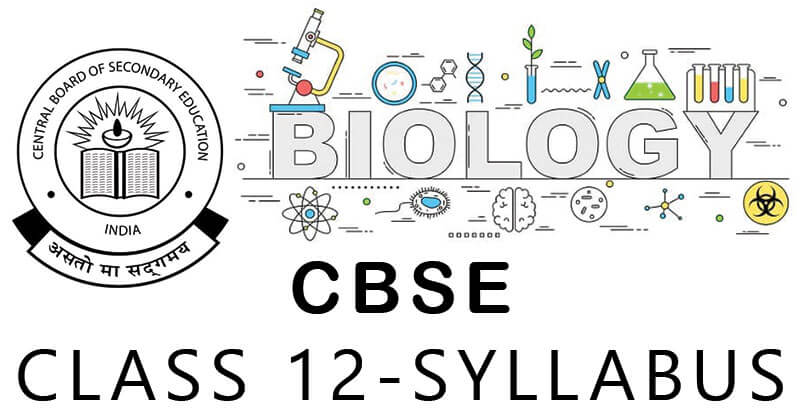
Interesting Science Videos
CBSE Class 12 Biology (Code No. 044) Course Structure
| Unit | Title | Marks |
| VI | Reproduction | 16 |
| VII | Genetics and Evolution | 20 |
| VIII | Biology and Human Welfare | 12 |
| IX | Biotechnology and its Applications | 12 |
| X | Ecology and Environment | 12 |
| Total | 70 |
CBSE Class 12 Biology Theory Syllabus 2022-2023
Unit-VI Reproduction
Chapter-2: Sexual Reproduction in Flowering Plants
Flower structure; development of male and female gametophytes; pollination – types, agencies and examples; out breeding devices; pollen-pistil interaction; double fertilization; post fertilization events – development of endosperm and embryo, development of seed and formation of fruit; special modes- apomixis, parthenocarpy, polyembryony; Significance of seed dispersal and fruit formation.
Chapter-3: Human Reproduction
Male and female reproductive systems; microscopic anatomy of testis and ovary; gametogenesis
-spermatogenesis and oogenesis; menstrual cycle; fertilisation, embryo development upto blastocyst formation, implantation; pregnancy and placenta formation (elementary idea); parturition (elementary idea); lactation (elementary idea).
Chapter-4: Reproductive Health
Need for reproductive health and prevention of Sexually Transmitted Diseases (STDs); birth control – need and methods, contraception and medical termination of pregnancy (MTP); amniocentesis; infertility and assisted reproductive technologies – IVF, ZIFT, GIFT (elementary idea for general awareness).
Unit-VII Genetics and Evolution
Chapter-5: Principles of Inheritance and Variation
Heredity and variation: Mendelian inheritance; deviations from Mendelism – incomplete dominance, co-dominance, multiple alleles and inheritance of blood groups, pleiotropy;
elementary idea of polygenic inheritance; chromosome theory of inheritance; chromosomes and genes; Sex determination – in humans, birds and honey bee; linkage and crossing over; sex linked inheritance – haemophilia, colour blindness; Mendelian disorders in humans – thalassemia; chromosomal disorders in humans; Down’s syndrome, Turner’s and Klinefelter’s syndromes.
Chapter-6: Molecular Basis of Inheritance
Search for genetic material and DNA as genetic material; Structure of DNA and RNA; DNA packaging; DNA replication; Central Dogma; transcription, genetic code, translation; gene expression and regulation – lac operon; Genome, Human and rice genome projects; DNA fingerprinting.
Chapter-7: Evolution
Origin of life; biological evolution and evidences for biological evolution (paleontology, comparative anatomy, embryology and molecular evidences); Darwin’s contribution, modern synthetic theory of evolution; mechanism of evolution – variation (mutation and recombination) and natural selection with examples, types of natural selection; Gene flow and genetic drift; Hardy – Weinberg’s principle; adaptive radiation; human evolution.
Unit-VIII Biology and Human Welfare
Chapter-8: Human Health and Diseases
Pathogens; parasites causing human diseases (malaria, dengue, chikungunya, filariasis,
ascariasis, typhoid, pneumonia, common cold, amoebiasis, ring worm) and their control; Basic concepts of immunology – vaccines; cancer, HIV and AIDS; Adolescence – drug and alcohol abuse.
Chapter-10: Microbes in Human Welfare
Microbes in food processing, industrial production, sewage treatment, energy generation and microbes as bio-control agents and bio-fertilizers. Antibiotics; production and judicious use.
Unit-IX Biotechnology and its Applications
Chapter-11: Biotechnology – Principles and Processes
Genetic Engineering (Recombinant DNA Technology).
Chapter-12: Biotechnology and its Application
Application of biotechnology in health and agriculture: Human insulin and vaccine production, stem cell technology, gene therapy; genetically modified organisms – Bt crops; transgenic animals; biosafety issues, biopiracy and patents.
Unit-X Ecology and Environment
Chapter-13: Organisms and Populations
Population interactions – mutualism, competition, predation, parasitism; population attributes – growth, birth rate and death rate, age distribution. (Topics excluded: Organism and its Environment, Major Aboitic Factors, Responses to Abioitic Factors, Adaptations)
Chapter-14: Ecosystem
Ecosystems: Patterns, components; productivity and decomposition; energy flow; pyramids of number, biomass, energy (Topics excluded: Ecological Succession and Nutrient Cycles)
Chapter-15: Biodiversity and Conservation
Biodiversity-Concept, patterns, importance; loss of biodiversity; biodiversity conservation; hotspots, endangered organisms, extinction, Red Data Book, Sacred Groves, biosphere reserves, national parks, wildlife, sanctuaries and Ramsar sites.
Read Also- CBSE Class 11 Biology Latest Syllabus (2022-2023)
CBSE Class 12 Biology Practicals Evaluation Scheme
| Evaluation Scheme | Marks |
| One Major Experiment (5) | 5 |
| One Minor Experiment (2, 3) | 4 |
| Slide Preparation (1, 4) | 5 |
| Spotting | 7 |
| Practical Record + Viva Voce | 4 |
| Investigatory Project and its Project and its Record + Viva Voce | 5 |
| Total | 30 |
Download PDF of CBSE Class 12 Biology Syllabus (2022-2023)
A. List of Experiments
- Prepare a temporary mount to observe pollen germination.
- Study the plant population density by quadrat method.
- Study the plant population frequency by quadrat method.
- Prepare a temporary mount of onion root tip to study mitosis.
- Isolate DNA from available plant material such as spinach, green pea seeds, papaya, etc.
B. Study and observer the following (Spotting):
- Flowers adapted to pollination by different agencies (wind, insects, birds).
- Pollen germination on stigma through a permanent slide or scanning electron micrograph.
- Identification of stages of gamete development, i.e., T.S. of testis and T.S. of ovary through permanent slides (from grasshopper/mice).
- Meiosis in onion bud cell or grasshopper testis through permanent slides.
- T.S. of blastula through permanent slides (Mammalian).
- Mendelian inheritance using seeds of different colour/sizes of any plant.
- Prepared pedigree charts of any one of the genetic traits such as rolling of tongue, blood groups, ear lobes, widow’s peak and colour blindness.
- Controlled pollination – emasculation, tagging andbagging.
- Common disease causing organisms like Ascaris, Entamoeba, Plasmodium, any fungus causing ringworm through permanent slides, models or virtual images or specimens. Comment on symptoms of diseases that they cause.
- Models specimen showing symbolic association in root modules of leguminous plants, Cuscuta on host, lichens.
- Flash cards models showing examples of homologous and analogous organs.
Prescribed Books for CBSE Class 12 Biology
- Biology, Class-XII, Published by NCERT
- Other related books and manuals brought out by NCERT (including multimedia)
- Biology Supplementary Material (Revised). Available on CBSE website.
